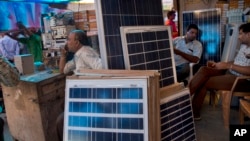Small solar units with two lamps installed in the 61 houses in the remote Baripatha village in India’s eastern Orissa state this month lit up a tiny rural hamlet that had long relied on polluting kerosene lamps after dusk.
Baripatha is the latest to join hundreds of other villages that have been powered with clean energy harnessed from the sun in recent years.
Jakson, the company that co-funded and implemented the rural project, is optimistic about the rapid expansion of solar power since it started just three years ago.
“We are betting very big on solar,” said Vice President Sandip Ghosh, whose company also backs two large-scale, 30 megawatt power plants.
Quintupling solar power in 7 years
Across India, companies are aggressively ramping up solar projects as the government sets out an ambitious target to achieve a five-fold increase in renewable energy capacity in the next seven years. That would mean generating 100 gigawatts of solar power by 2022, up from the present total of four gigawatts.
India hopes the massive push for solar energy will help it slow the rate at which its greenhouse gas emissions are growing.
India is the world’s third largest emitter of greenhouse gases, but it plans to radically reshape its energy use in a short period of time.
“In terms of the share of electricity capacity that Germany achieved through renewables, that transition took about 22 years for Germany," said Arunabha Ghosh of the policy research institution, the Council on Energy, Environment and Water in New Delhi. "In India’s case, which is a much poorer economy, India is planning to have a similar shift towards renewable energy and non-fossil energy within a span of 15 years.”
India’s goal has become viable largely due to the dramatic drop in the cost of solar power generation.
Hoping to attract $100 billion over seven years for its solar sector, the government is offering tax breaks and allowing 100 percent foreign investment.
There is a rush of interest. Germany this week promised $2.25 billion to develop a clean energy corridor and solar projects in India. Others who have lined up include the U.S.-based renewable energy firm SunEdison, which wants to invest $15 billion. Japan’s SoftBank has announced a $20 billion joint venture with an Indian and Taiwanese firm to bid for solar contracts, while China’s Trina Solar plans to invest $500 million to make solar panels.
“We see a huge interest of international investors that are ready to commit sums of money that we have not seen in the solar world anywhere before, and that is more comparable to a large scale energy investment for example in the oil or thermal power. So these are huge, momentous changes,” said Tobias Engelmeier, founder of the renewable energy consultancy, Bridge to India.
Some have expressed worries about the availability of land for such large-scale, land intensive solar projects.
But one of the early entrants in the sector, Inderpreet Wadhwa, founder of Azure Power, brushed aside such concerns, saying solar projects are largely coming up in infertile, arid areas. “You are not displacing any alternative use of land, especially if you are building in remote areas in Rajasthan for example. If you are selecting wasteland, then it becomes an easy process to manage.”
Coal offsets, solar’s gains
Even as India races to harness the sun, its huge appetite for energy is also leading it to dig deep inside the earth for coal, hoping to double output in five years. The haul is for new coal-fired electrical plants, considered to be the most polluting.
India said it has no alternative for its coal dependence. Nearly a quarter of its population -- some 300 million people -- still have no access to electricity. Towns and cities suffer from chronic power outages.
Environmentalists warn that the new coal based power plants mean that India’s share of carbon emissions will continue to rise for many years.
But Arunabha Ghosh points out those concerns must be seen in perspective.
“People don’t seem to recognize that it is not a question of will more coal be built or not. It is a question of how much coal is not going to be built because of these aggressive targets. We are going from about eight to 13 percent of renewable energy in mid century to 30 percent by 2030. That is the shift from the baseline.”
Unlike China and the United States, India has not set a date to either cap or cut its carbon emissions. It is only aiming to slow down the rise, arguing that its per capita emissions are far lower than that of countries like the U.S., and that much of the India of 2030 has yet to be built.








